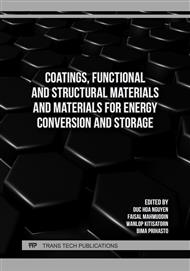[1]
K.S. Novoselov, V.I. Fal'Ko, L. Colombo, P.R. Gellert, M.G. Schwab, K. Kim, A roadmap for graphene, Nature 490 (2012) 192–200.
DOI: 10.1038/nature11458
Google Scholar
[2]
Z. Xie, X. Meng, X. Li, W. Liang, W. Huang, K. Chen, J. Chen, C. Xing, M. Qiu, B. Zhang, G. Nie, N. Xie, X. Yan, H. Zhang, Two-Dimensional Borophene: Properties, Fabrication, and Promising Applications, Research 2020 (2020).
DOI: 10.34133/2020/2624617
Google Scholar
[3]
Z. Zhen, H. Zhu, Structure and properties of graphene, in: Graphene: Fabrication, Characterizations, Properties and Applications, Elsevier, 2017: p.1–12.
Google Scholar
[4]
Z. Wang, F. Gao, N. Li, N. Qu, H. Gou, X. Hao, Density functional theory study of hexagonal carbon phases, Journal of Physics Condensed Matter 21 (2009).
DOI: 10.1088/0953-8984/21/23/235401
Google Scholar
[5]
M.L. Hu, Z. Yu, J.L. Yin, C.X. Zhang, L.Z. Sun, A DFT-LDA study of electronic and optical properties of hexagonal boron nitride under uniaxial strain, Comput Mater Sci 54 (2012) 165–169.
DOI: 10.1016/j.commatsci.2011.10.041
Google Scholar
[6]
A.M. Rojas-Cuervo, K.M. Fonseca-Romero, R.R. Rey-González, Anisotropic dirac cones in monoatomic hexagonal lattices: A DFT study, European Physical Journal B 87 (2014).
DOI: 10.1140/epjb/e2014-40894-9
Google Scholar
[7]
S. Thomas, M.S. Manju, K.M. Ajith, S.U. Lee, M. Asle Zaeem, Strain-induced work function in h-BN and BCN monolayers, Physica E Low Dimens Syst Nanostruct 123 (2020).
DOI: 10.1016/j.physe.2020.114180
Google Scholar
[8]
H. Åžahin, M. Topsakal, S. Ciraci, Structures of fluorinated graphene and their signatures, Phys Rev B Condens Matter Mater Phys 83 (2011).
DOI: 10.1103/physrevb.83.115432
Google Scholar
[9]
D.D. Chronopoulos, A. Bakandritsos, M. Pykal, R. Zbořil, M. Otyepka, Chemistry, properties, and applications of fluorographene, Appl Mater Today 9 (2017) 60–70.
DOI: 10.1016/j.apmt.2017.05.004
Google Scholar
[10]
V. Hrubý, V. Šedajová, P. Jakubec, A. Bakandritsos, R. Zbořil, M. Otyepka, Unleashing the power: Superior properties of fluorographene-derived materials for energy storage applications, Power Electronic Devices and Components 7 (2024).
DOI: 10.1016/j.pedc.2024.100058
Google Scholar
[11]
J.P. Perdew, K. Burke, M. Ernzerhof, Generalized Gradient Approximation Made Simple, 1996.
Google Scholar
[12]
H.J. Monkhorst, J.D. Pack, Special points for Brillonin-zone integrations*, 1976.
Google Scholar
[13]
Q. Wei, X. Peng, Superior mechanical flexibility of phosphorene and few-layer black phosphorus, Appl Phys Lett 104 (2014).
DOI: 10.1063/1.4885215
Google Scholar
[14]
Y. Li, F. Li, Z. Chen, Graphane/fluorographene bilayer: Considerable C-H⋯F-C hydrogen bonding and effective band structure engineering, J Am Chem Soc 134 (2012) 11269–11275.
DOI: 10.1021/ja3040416
Google Scholar
[15]
F. Mouhat, F.X. Coudert, Necessary and sufficient elastic stability conditions in various crystal systems, Phys Rev B Condens Matter Mater Phys 90 (2014).
DOI: 10.1103/physrevb.90.224104
Google Scholar
[16]
N.H. Linh, N.M. Son, T.T. Quang, N. Van Hoi, V. Thanh, D. Van Truong, First-Principles Investigation on the Electromechanical Properties of Monolayer 1H Pb-Dichalcogenides, Korean Journal of Materials Research 33 (2023) 189–194.
DOI: 10.3740/mrsk.2023.33.5.189
Google Scholar
[17]
R. Fanta, M. Dubecký, Toward automated screening of band gap sensitivity in 2D materials, JPhys Materials 6 (2023).
DOI: 10.1088/2515-7639/acef97
Google Scholar
[18]
H. Åžahin, M. Topsakal, S. Ciraci, Structures of fluorinated graphene and their signatures, Phys Rev B Condens Matter Mater Phys 83 (2011).
DOI: 10.1103/physrevb.83.115432
Google Scholar



